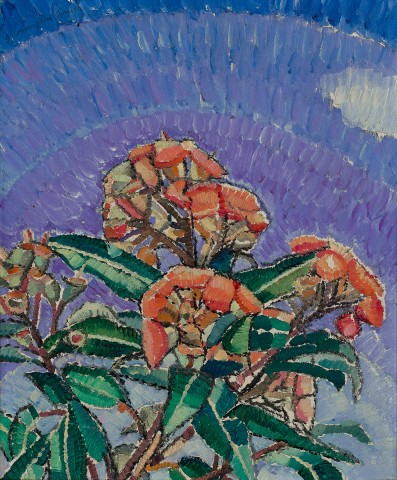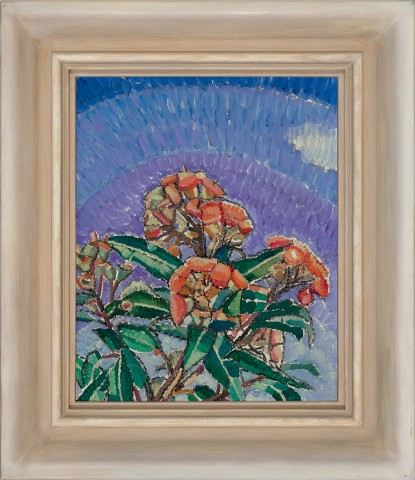GUM BLOSSOM, c.1928 – 32
GRACE COSSINGTON SMITH
oil on pulpboard
33.0 x 27.0 cm
signed upper left: G Cossington Smith
bears inscription verso: GUM BLOSSOM
Private collection, New South Wales
Sotheby’s, Sydney, 25 August 2003 (private sale)
Private collection, Sydney
Paintings and Drawings by Grace Cossington Smith, Macquarie Galleries, Sydney, 21 July 1937, cat. 2
Enid Cambridge and Grace Cossington Smith, Macquarie Galleries, Sydney, 22 July – 3 August 1942, cat. 7
Grace Cossington Smith, Macquarie Galleries, Sydney, 13 – 25 June 1945, cat. 19
Gum Blossom, c.1928 – 32 by Grace Cossington Smith is a radiant, even ecstatic, paean to the sublime effects of light and colour. It was painted at a time when the artist was creating some of the most memorable works in her long career, including Bridge in Curve, 1930 (National Gallery of Victoria); The Gully, 1928 (Kerry Stokes Collection); and the delightfully intimate Krinkley Konks Sleeping, 1927 – 28 (private collection), an affectionate study of the family’s bulldog built upon keen observation and a pattern of short brushstrokes. Cossington Smith remains one of the most distinctive early modernists that this country has produced – an artist who used still lifes as ‘as a lens for aesthetically honing in on the sensations of a private universe’1 as the rhythmic pulse of paintings such as Gum Blossom perfectly encapsulates.
Cossington Smith studied during World War One alongside Roy de Maistre, Roland Wakelin and Constance Tempe Manning at the forward-looking atelier run by the Italian expatriate Antonio Dattilo-Rubbo. All were energised by aesthetic ideas then emerging from Europe, particularly Post-Impressionism, and Cossington Smith’s early masterwork The Sock Knitter, 1915 (Art Gallery of New South Wales) is cited as being Australia’s first ‘modern’ painting. Cézanne was a touchstone for the students and Wakelin would later write of this, noting particularly Cézanne’s concept of the ‘rhythmic flow of line – that concentric feeling in the design, the feeling of “radiation from the centre”’2; again, a notion that can be keenly detected within Gum Blossom spectacular array of colour vibrations. In developing her own direction, Cossington Smith was also inspired by the writings of Beatrice Irwin, an English poet-performer who travelled the world, including Australia, giving ‘Colour-Poem’ recitals which underpinned her widely read book The New Science of Color (1915). Irwin was ‘interested in radiating colours: in colour waves, auras and vibrations, and in the capacity of colour to transform our state of mind.’3 After her studies, Cossington Smith continued her experiments in the relative isolation of the family home on Sydney’s north shore, but following de Maistre’s return in late 1925 from a Travelling Scholarship in Europe, the two renewed their friendship and went on a number of painting excursions together in the Southern Highlands. It was during this period that she received some salient advice: ‘I can remember Roy de Maistre saying years ago, ‘You don’t want to make your skies so heavy’, and I said, ‘But the blue is such a very deep blue… and he said, ‘Yes, it is deep blue, but you’ve got to remember that it’s also light.’ And that’s just it.’4 De Maistre also encouraged her use of clearly delineated brushstrokes, seen expressively in the background of Gum Blossom, as well as in Bridge in Curve, where the sky swells with vigorous marks blue paint underscored by penetrating whites. In both paintings, ‘rhythm and energy have become… primary vehicles (implying) the larger, eternal movement and unity of all matter.’5
Cossington Smith included Gum Blossom in a two-person exhibition with her friend Enid Cambridge at the renowned Macquarie Galleries in Sydney and it is a characteristic example, executed in the artist’s distinctive ‘firm, separate notes of clear, unworried colour.’6
1. Mimmocchi, D., ‘Still life as laboratory’ in Sydney Moderns: Art for a New World, Art Gallery of New South Wales, Sydney, 2013, p. 200
2. Wakelin, R., ‘The modern movement in Australia’, Art in Australia, no. 26, December 1928, n.p.
3. Hart, D. (ed.), Grace Cossington Smith, National Gallery of Australia, Canberra, 2005, p. 27
4. Grace Cossington Smith, Interview with Alan Roberts, 28 April 1970, National Gallery of Australia, cited in Hart, D., ibid., p. 39, fn 104
5. Edwards, D., ‘Landscapes of modernity 1920s – 40s’ in Mimmocchi, D., ibid., p. 217
6. Grace Cossington Smith, cited in Thomas, D., Grace Cossington Smith, Art Gallery of New South Wales, Sydney, 1973, p. 6
ANDREW GAYNOR


